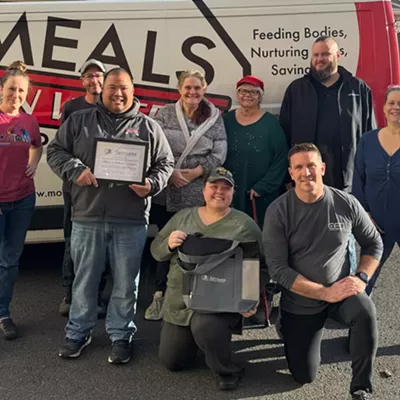
Swaddled in pink blankets, Paisley and Presley's little faces peek out, their eyes closed peacefully. Miniature tubes pump air through their noses and milk into their bellies. Here, everything is tiny.
Twice today, and every day until she can take them home, Tori Westacott will hold each of her 34-week-old twins (born at 32 weeks) against her bare chest, feeling their fragile bodies move up and down with each breath.
The technique, known as kangaroo care or simply "skin-to-skin contact," has become more common here in the Neonatal Intensive Care Unit at Deaconess and in other hospitals around the globe. Researchers and doctors say the process improves respiratory function (one of the most difficult challenges facing babies born prematurely is breathing properly, since most of them have not yet formed fully functioning lungs), enhanced cognitive function, weight gain and stronger mother-child bonding. And while it's new to North America, kangaroo care was born long ago out of necessity in developing countries with scarce access to care and technology.
"In high-income countries, access to modern technology and resources may alleviate the need to use [kangaroo care] to improve survival of low-birthweight infants," wrote Ann Jefferies of the Canadian Paediatric Society in an overview of the method last year. "Nevertheless, the practice of skin-to-skin contact between the preterm infant and parent ... is one way of involving both mothers and fathers in the care of their at-risk infant and helps to humanize the NICU experience."
For Westacott, that has been especially true. She and her husband live in Oaksdale, about 40 miles southeast of Spokane, and they're first-time parents. She had her baby shower the day before rising blood pressure forced her doctors to perform a C-section and transfer her babies to their beds in a small room in the NICU, where the lights are low and holiday cutouts cling to the windows. Not only is it difficult to leave them each night, Westacott says, but it's hard to imagine that it could be nearly a month before they can come home with their parents. (Babies born prematurely are usually released near the mother's due date.)
"When I go out, I'll see people with their babies and I'm like, 'Why did they get their baby?' It's hard," Westacott says, looking down at Presley. "You don't think about your babies having to stay here. You imagine the day they're born, you imagine being in the hospital a day and then taking them home."
Skin-to-skin contact can help parents with those feelings of disconnection and help finish the process of bonding between mothers and babies that begins in the womb.
"They're with the mom. The warmth, the heartbeat's there," says Patrice Sweeny, the director of the Deaconess NICU. "It's as close to a womb-like environment as you can get. ... It just promotes total well-being of these infants."
Sweeny says the practice has taken hold in the past few years as the hospital has focused more on premature babies' "developmental care." With well-developed technology to help them breathe and eat, techniques to ensure healthy mental development are becoming a bigger focus. Because babies' senses are developing quickly, Sweeny says doctors and nurses are even more gentle with the babies than in the past, careful not to provide too many stimuli too quickly when caring for them.
Efforts are also underway to improve neonatal care at Sacred Heart. Keith Georgeson, a pediatric surgeon at the helm of Sacred Heart's children's hospital, says the recent industry shift toward requiring women to be at least 39 weeks pregnant to have an early C-section, sometimes called "designer delivery," has been "astounding" in reducing the number of problems premature babies face.
He points to various efforts: doctors are able to better cool down babies who didn't get enough oxygen to their brains during birth in order to reduce their risk of neurological damage; minimally invasive surgery is now possible on babies; intubation is used less often in favor of less invasive and damaging techniques, like masks, to help babies breathe; efforts like intravenous Tylenol are replacing narcotics for some babies; and new technologies are allowing anesthetics to be applied through the skin without a needle.
"We're in a war against pain right now," Georgeson says.
Both hospitals offer smaller rooms for premature or at-risk babies as opposed to large nursery rooms, offering more privacy for families and a more intimate, homelike connection.
"When technology first started to develop, we sort of put a wall between parents and premature babies," Georgeson says. "More and more, we're getting parents involved in care even when their baby is hooked up to all kinds of monitors and devices. There's a definite physiological improvement in babies, and it's good for parents as well because otherwise they feel helpless."♦

















